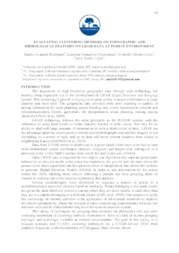Evaluating clustering methods on topographic and hydrological features on lidar data at forest environment.
Evaluating clustering methods on topographic and hydrological features on lidar data at forest environment.
Author(s): RODRIGUES, D. A.; VENDRUSCULO, L. G.; ZOLIN, C. A.; LOPES, T. R.
Summary: The acquisition of high resolution geographic data through laser technology has recently being expanded due to the development of LiDAR (Light Detection and Ranging) system. This technology?s growth is relying on its great ability to acquire information in large quantity and short time. The geographic data provided from laser scanning is capable of raising information for coast planning, assess flooding risk, power transmission network and telecommunication, forests, agriculture, oil, transportation, urban planning, mining, among others (GIONGO et al., 2010). LiDAR technology follows the same principles as the RADAR system, with the difference of using laser pulses to locate features, instead of radio waves. Not only for its ability to deal with large amounts of information in such a short period of time, LiDAR has the advantage upon the classic passive sensors (aerial photographs and satellite images) of not depending on a source of light, and so its data will never present shadows from clouds or neighboring features (GIONGO et al., 2010). Data from LiDAR sensor is distributed in a point cloud where each point has at least three-dimensional spatial coordinates (latitude, longitude and height) that correspond to a particular point on the Earth?s surface from which the laser pulse was reflected. Once LiDAR data is acquired the next step is use algorithms that separate points (also referred to as returns) on the point cloud that represents the ground and the ones above the ground level, those algorithms can then process series of interpolation that allows the operator to generate Digital Elevation Models (DEMs). In order to add information for the points within the DEM, labeling those returns following a pattern and then grouping them on clusters is useful as one of the steps in exploratory data analysis. Several methodologies were developed to organize a pattern of points in a multidimensional space into clusters based on similarity. Points belonging to the same cluster are given the same label and present a pattern where they are more similar to each other than they are to a pattern belonging to a different cluster (JAIN et al., 1999). One example to apply this technology on forestry activities is the application of silvicultural treatment to improve the forest?s productivity, where the decision is taken considering characteristics from the site and sites with similar characteristics may have the same silvicultural system. The variety of techniques for grouping data elements has produced a rich and often confusing assortment of clustering methods. Furthermore, there is a lack of studies grouping topologic and hydrologic variables at forested environments. The goal of this survey is to evaluate k-means and CLARA clustering techniques on a LiDAR-derived DEM from southern Amazonia, in the municipality of Cotriguaçu, Mato Grosso, Brazil.
Publication year: 2017
Types of publication: Paper in annals and proceedings
Keywords: Flooding risk, LiDAR, Raising information
Observation
Some of Embrapa's publications are published as ePub files. To read them, use or download one of the following free software options to your computer or mobile device. Android: Google Play Books; IOS: iBooks; Windows and Linux: Calibre.
Access other publications
Access the Agricultural Research Database (BDPA) to consult Embrapa's full library collection and records.
Visit Embrapa Bookstore to purchase books and other publications sold by Embrapa.

